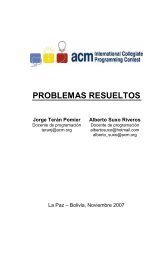Soluciones y Explicación de los problemas ACM ... - ICPC Bolivia
Soluciones y Explicación de los problemas ACM ... - ICPC Bolivia
Soluciones y Explicación de los problemas ACM ... - ICPC Bolivia
Create successful ePaper yourself
Turn your PDF publications into a flip-book with our unique Google optimized e-Paper software.
Explicaciones a <strong>los</strong> <strong>problemas</strong> South American Regionals 2008 47<br />
Problem J<br />
Higgs Boson<br />
Source file name: higgs.c, higgs.cpp or higgs.java<br />
It’s been 100 years since the <strong>de</strong>tection of the first Higgs boson and now particle physics is<br />
a mainstream subject in all high schools. Obviously, kids love the fact that they can create<br />
tiny black holes using only their portable particle accelerators and show off to their friends<br />
and colleagues. Although the creation of big black holes that could swallow the whole planet<br />
is possible even with these portable particle accelerators, the <strong>de</strong>vices are programmed to only<br />
thrown particles when this un<strong>de</strong>sirable si<strong>de</strong> effect is impossible.<br />
Your granddaughter is trying to create her own black holes with a portable accelerator kit, which<br />
is composed of two small particle accelerators that throw, each one, a boson-sized particle.<br />
Both particles are thrown at the same time, and a black hole appears when the particles<br />
colli<strong>de</strong>. However, your granddaughter doesn’t know how much time she’ll have to wait before<br />
this happens. Fortunately, each accelerator can predict the particle’s trajectory, showing four<br />
integer values into its display, called A, B, C and D. Each value can be replaced into the<br />
following equations:<br />
r = At + B<br />
θ = Ct + D<br />
in or<strong>de</strong>r to <strong>de</strong>termine the trajectory of the particle, in polar coordinates. The radius (r) is<br />
represented in distance units and the angle (θ) in <strong>de</strong>grees. The time (t) is given in time units<br />
and it is always a rational value which can be represented by an irreducible fraction. Your<br />
granddaughter knows that in polar coordinates a point has infinite representations. In general,<br />
the point (r, θ) can be represented as (r, θ ± k × 360 o ) or (−r, θ ± (2k + 1) × 180 o ), where k is<br />
any integer. Besi<strong>de</strong>s, the origin (r = 0) can be represented as (0, θ) for any θ.<br />
Using these parameters informed by each particle accelerator, your granddaughter wants to<br />
<strong>de</strong>termine whether the particles will eventually colli<strong>de</strong> and, if they do, the time when they will<br />
colli<strong>de</strong>. After the first collision it is impossible to predict the particle’s trajectory, therefore,<br />
only the first possible collision should be consi<strong>de</strong>red.<br />
Although your granddaughter is really intelligent and has a <strong>de</strong>ep knowledge of particle physics,<br />
she does not know how to program computers and is looking for some notes in her grandfather’s<br />
(or grandmother’s) <strong>ICPC</strong> notebook (don’t forget, she is your granddaughter!). Fortunately for<br />
you, there is a note on your notebook which says that you wrote that co<strong>de</strong> during the 2008<br />
<strong>ICPC</strong> South America Regional Contest (or, to be more specific, this contest).<br />
Input<br />
The input consists of several test cases, one per line. Each test case contains eight integer numbers<br />
separated by single spaces, A1, B1, C1, D1, A2, B2, C2, D2 (−10 4 ≤ A1, B1, C1, D1, A2, B2,<br />
C2, D2 ≤ 10 4 ). The first four input values (A1, B1, C1, D1) correspond to the four parameters<br />
displayed by the first portable particle accelerator and the following input values (A2, B2, C2, D2)<br />
correspond to the four parameters displayed by the second portable particle accelerator when<br />
both particles are thrown. The end of the input is represented by A1 = B1 = C1 = D1 = A2 =



